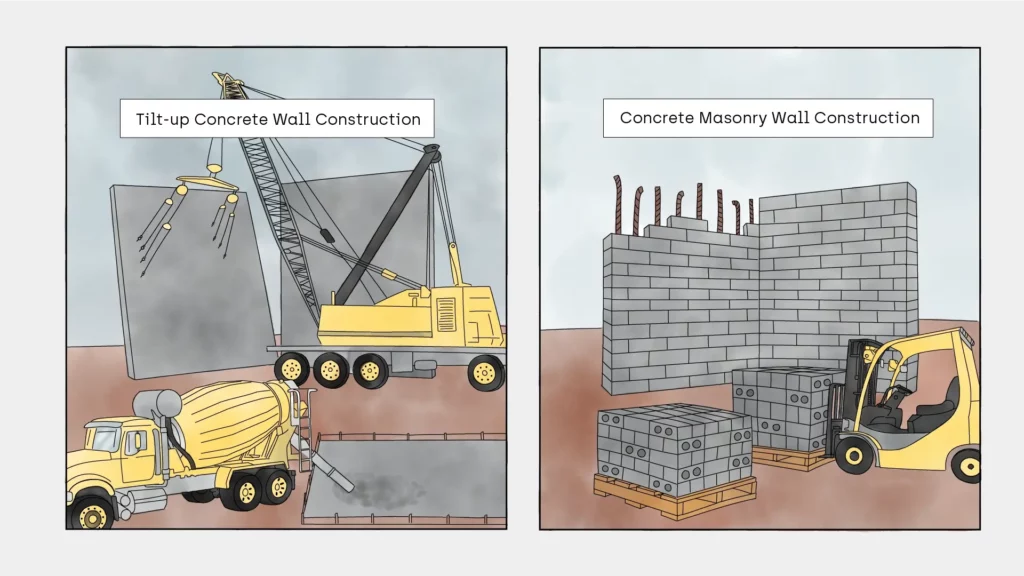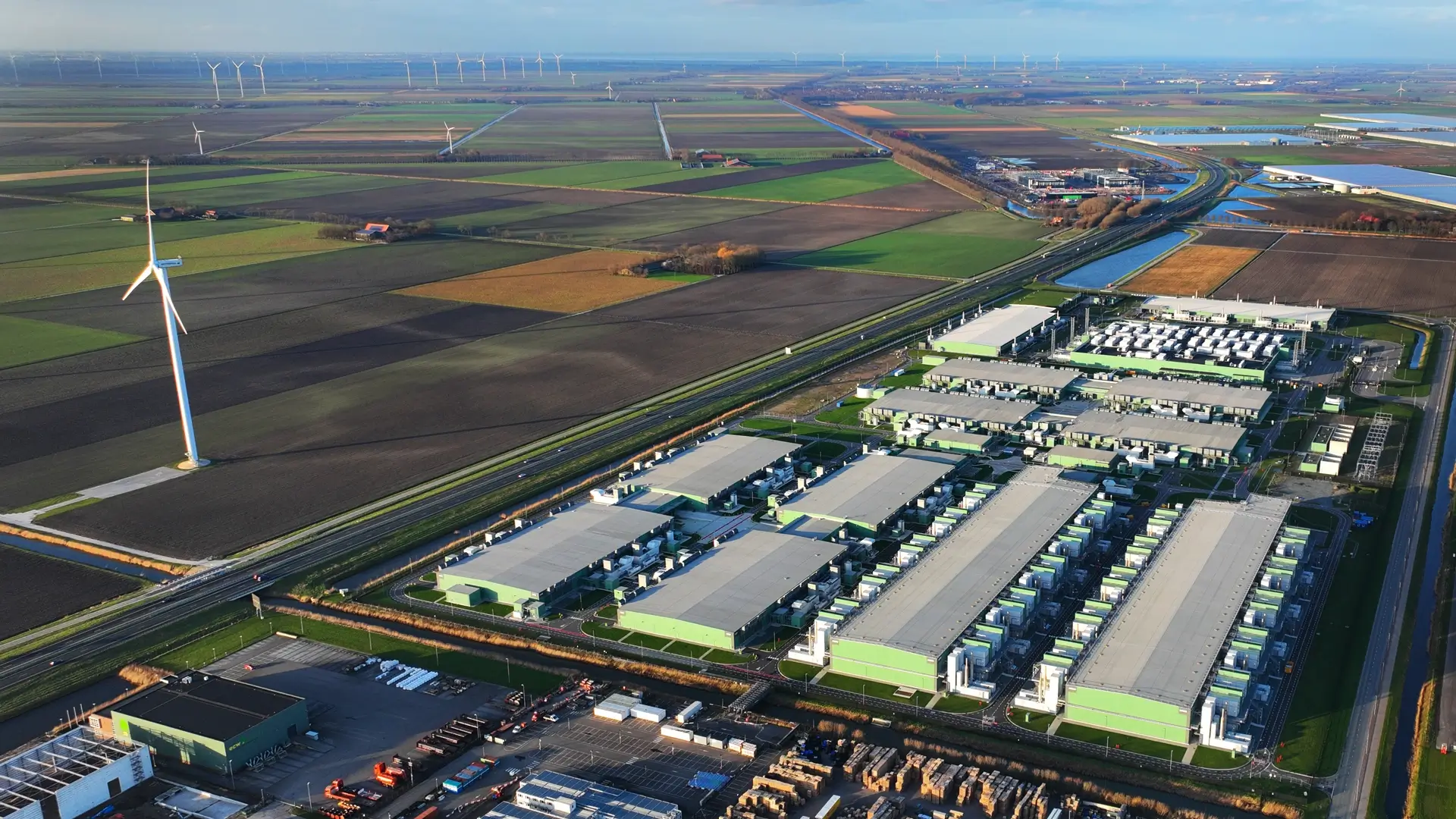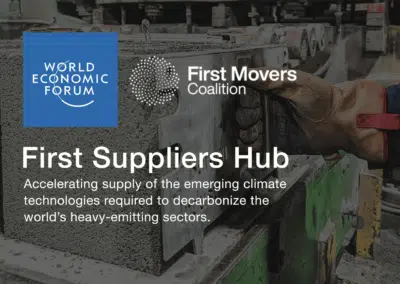50-70 percent reduction in embodied carbon of concrete walls quickly & cost-effectively boosts sustainability of crucial digital infrastructure
LOS ANGELES | December 14, 2023
A new study by leading structural engineering firm KPFF Consulting Engineers shows that switching to ultra-low carbon concrete masonry units (CMU, or “blocks”) such as those made with CarbonBuilt technology can reduce the embodied carbon of concrete walls by up to 70 percent at comparable costs versus the traditional “tilt-up” construction method.
This simple switch will overcome the seemingly intractable problem of massive emissions related to concrete use in these facilities.

It is estimated that concrete contributes nearly 50 percent of the embodied carbon of a typical building.
The construction of data centers and logistics facilities will skyrocket in the coming years thanks to the growing use of artificial intelligence (37 percent CAGR) and same-day delivery (24 percent CAGR). This will require the production of millions of tons of concrete in the US alone, which will in turn produce millions of tons of CO2, magnifying climate disruption in the coming years.
But new research from KPFF, conducted for CarbonBuilt, shows there is a way to radically reduce the embodied carbon of concrete used in these facilities through an alternative to the current tilt-up process which is the primary wall construction method.
By substituting cast-in-place (or “ready-mix” concrete) with concrete blocks, builders can get to the same end result with up to 70 percent less embodied carbon in its walls at costs comparable to tilt-up.
To reach these conclusions, KPFF compared the use of ultra-low carbon masonry against traditional tilt-up construction for an 87,500 gross square foot industrial warehouse built in 2022 with 38-foot concrete exterior wall panels. KPFF developed a preliminary structural redesign for the same facility using ultra-low carbon concrete blocks to compare cost and constructibility.
CarbonBuilt projected the carbon impacts using a life cycle analysis (LCA) for the two different wall types, integrating existing Environmental Product Disclosures (EPDs) for conventional products (including ready-mix concrete, rebar, grout and mortar) and projected EPDs for its blocks.
The study projects embodied carbon reductions of 48 to 70 percent for the walls at a cost increase of only 1 to 2 percent for the total project.
The study also noted that there are a number of emerging construction technologies, including robotics, that could further reduce costs, effectively leveling costs with tilt-up construction.
“For a given warehouse or data center project, there is nothing that would preclude me from considering both tilt-up and CMU on an equal basis.”
— Jeff Asher, Managing Principal and Past President-Chairman, KPFF Consulting Engineers and author of the study
“It’s urgent that the construction industry apply an application-specific lens when selecting concrete methods and materials throughout the building system in line with reducing embodied carbon impacts.”
According to the Infrastructure Masons Climate Accord (ICA) in its publication Greener Concrete for Digital Infrastructure: An Open Letter and Call to Action released in April 2023, “concrete alone makes up 11% of total global emissions. In accordance with [the ICA’s] broader sustainability goals, we recognize the urgency to reduce the embodied carbon of our building materials, specifically through the use of greener concrete.”
The Climate Accord and its signatories are a coalition united on carbon reduction in digital infrastructure, with a mandate to achieve global carbon accounting of digital infrastructure and drive the industry to achieve carbon neutrality.
“Our 200+ members include the leading developers and users of data centers worldwide. They’ve driven great advancements in reducing operational CO2 emissions through energy efficiency, renewable power and sustainable materials,” said Miranda Gardiner, Executive Director, iMasons Climate Accord.
“Now our industry is focused on reductions to embodied carbon, given the enormous scale of these types of emissions. We welcome companies who are demonstrating how relatively small changes in design and construction methods can yield significant improvements without increased overall costs.”
— Miranda Gardiner, Executive Director, iMasons Climate Accord
A full version of the KPFF Study and PowerPoint are available here.
ABOUT CARBONBUILT®
CarbonBuilt, winner of the NRG COSIA Carbon XPRIZE, enables concrete manufacturers to produce ultra-low carbon concrete products with 70-100+% less embodied carbon. CarbonBuilt’s technology replaces most of the expensive, high-carbon Portland cement typically used during concrete manufacturing with a proprietary low-cost cement alternative made from widely-available low carbon materials. These materials harden after chemically reacting with CO2, to not only strengthen the blocks, but also permanently store the CO2 in solid form, diverting it from the atmosphere. Because it can be cost-effectively installed at existing concrete manufacturing plants and delivers products that meet ASTM C90 and other applicable industry standards without increasing costs, CarbonBuilt’s technology can be rapidly adopted by the nearly 800 concrete plants in the U.S. alone. More information is available at www.carbonbuilt.com
ABOUT KPFF CONSULTING ENGINEERS®Founded in Seattle in 1960, KPFF Consulting Engineers has been continuously engaged in the practice of professional engineering for 63 years. KPFF provides structural and civil engineering services to architects, public agencies, developers, and contractors for a wide variety of projects. The firm currently consists of over 1,200 staff, located in 20 offices throughout the US. KPFF has always been on the forefront of innovation in the AEC industry, having achieved many engineering “firsts”. Our experience base is very diverse, and includes engineering services related to commercial, institutional, healthcare, schools, industrial, and infrastructure-related projects.KPFF is committed to stewardship of the environment and Earth’s valuable resources. With over 400 LEED certified buildings and many more pending certification, our design teams carefully balance sustainability with practicality, matching LEED objectives with real needs for optimum system performance. More information at www.kpff.com.




